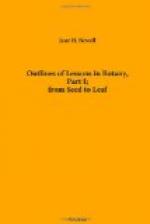[Footnote 2: The large Russian Sunflower is the best for the purpose.]
[Footnote 3: These lessons are intended, as has been said, for children over twelve years of age. If they are adapted for younger ones, it is especially important to begin with a seed where the leaf-like character of the cotyledons is evident, or becomes so. Maple is excellent for the purpose. Morning-Glory is too small. Squash will answer very well. I think it characteristic of the minds of little children to associate a term with the first specimen to which it is applied. If the term cotyledon be given them first for those of the Bean and Pea they will say when they come to the Morning-Glory, “but those are leaves, not cotyledons. Cotyledons are large and round.” It will be very difficult to make them understand that cotyledons are the first seed-leaves, and they will feel as if it were a forced connection, and one that they cannot see for themselves.]
The teacher’s object now is to make the pupils understand the meaning of the answers they have given to these questions. In the first place, they should go over their answers and substitute the botanical terms they have just learned for the ones they have used.
COMPARISON OF THE PARTS OF THE SOAKED SEEDS.
Morning-Glory. A seed covering. Some albumen. Two cotyledons. A caulicle.
Sunflower. An outer covering.[1] An inner covering. Two cotyledons. A caulicle.[2]
[Footnote 1: The so-called seed of Sunflower is really a fruit. The outer covering is the wall of the ovary, the inner the seed-coat. Such closed, one-seeded fruits are called akenes.]
[Footnote 2: The plumule is sometimes visible in the embryo of the Sunflower.]
Bean. A seed covering. Two cotyledons. A caulicle. A plumule.
Pea. The same as the Bean.
They have also learned how the first leaves in the last three differ from those of the Morning-Glory, being considerably thicker in the Sunflower, and very much thicker in the Bean and Pea. Why should the Morning-Glory have this jelly that the others have not? Why do the first leaves of the Sunflower change so much as the seedling grows? What becomes of their substance? Why do those of the Bean shrivel and finally drop off? By this time some bright pupil will have discovered that the baby-plant needs food and that this is stored around it in the Morning-Glory, and in the leaves themselves in the others. It is nourished upon this prepared food, until it has roots and leaves and can make its own living. The food of the Morning-Glory is called albumen; it does not differ from the others in kind, but only in its manner of storage.[1]
[Footnote 1: Reader in Botany. III. Seed-Food.]
Also the questions have brought out the fact that the Bean and Pea have the plumule ready formed in the seed, while the Morning-Glory and Sunflower have not. Why should this be? It is because there is so much food stored in the first two that the plumule can develop before a root is formed, while in the others there is only nourishment sufficient to enable the plantlet to form its roots. These must make the second leaves by their own labor.




